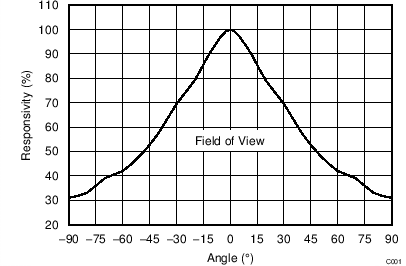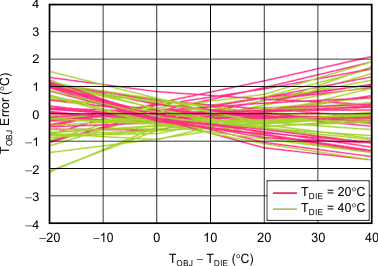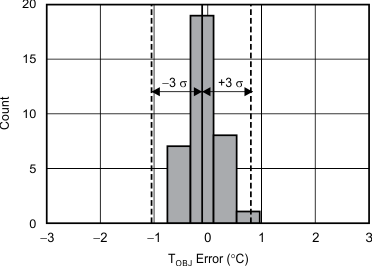SBOS518E May 2011 – April 2015 TMP006
PRODUCTION DATA.
- 1 Features
- 2 Applications
- 3 Description
- 4 Revision History
- 5 Device Comparison Table
- 6 Pin Configuration and Functions
- 7 Specifications
-
8 Detailed Description
- 8.1 Overview
- 8.2 Functional Block Diagram
- 8.3 Feature Description
- 8.4 Device Functional Modes
- 8.5 Register Maps
- 9 Application and Implementation
- 10Power-Supply Recommendations
- 11Layout
- 12Device and Documentation Support
- 13Mechanical, Packaging, and Orderable Information
Package Options
Mechanical Data (Package|Pins)
- YZF|8
Thermal pad, mechanical data (Package|Pins)
Orderable Information
7 Specifications
7.1 Absolute Maximum Ratings
over operating free-air temperature range (unless otherwise noted)(1)(1) Stresses beyond those listed under Absolute Maximum Ratings may cause permanent damage to the device. These are stress ratings only, which do not imply functional operation of the device at these or any other conditions beyond those indicated under Recommended Operating Conditions. Exposure to absolute-maximum-rated conditions for extended periods may affect device reliability.
7.2 ESD Ratings
| VALUE | UNIT | |||
|---|---|---|---|---|
| V(ESD) | Electrostatic discharge | Human-body model (HBM), per ANSI/ESDA/JEDEC JS-001(1) | ±2000 | V |
| Charged-device model (CDM), per JEDEC specification JESD22-C101(2) | ±500 | |||
| Machine model | ±200 | |||
(1) JEDEC document JEP155 states that 500-V HBM allows safe manufacturing with a standard ESD control process.
(2) JEDEC document JEP157 states that 250-V CDM allows safe manufacturing with a standard ESD control process.
7.3 Recommended Operating Conditions
over operating free-air temperature range (unless otherwise noted)| MIN | NOM | MAX | UNIT | ||
|---|---|---|---|---|---|
| Supply voltage, VS | 2.5 | 3.3 | 5.5 | V | |
| Operating temperature range | –40 | +125 | °C | ||
| Die temperature, TDIE | 125 | °C | |||
| Object temperature, TOBJ | See note (1) | °C | |||
(1) Object temperature is application dependent.
7.4 Thermal Information
| THERMAL METRIC(1) | TMP006 TMP006B |
UNIT | |
|---|---|---|---|
| YZF (DSBGA) | |||
| 8 PINS | |||
| RθJA | Junction-to-ambient thermal resistance | 123.8 | °C/W |
| RθJC(top) | Junction-to-case (top) thermal resistance | 69 | |
| RθJB | Junction-to-board thermal resistance | 103 | |
| ψJT | Junction-to-top characterization parameter | 4.7 | |
| ψJB | Junction-to-board characterization parameter | 55 | |
| RθJC(bot) | Junction-to-case (bottom) thermal resistance | N/A | |
(1) For more information about traditional and new thermal metrics, see the IC Package Thermal Metrics application report, SPRA953.
7.5 Electrical Characteristics
At TDIE = +25°C, V+ = 3.3 V, and conversion time = 1 second, unless otherwise specified.| PARAMETER | TEST CONDITIONS | MIN | TYP | MAX | UNIT | ||
|---|---|---|---|---|---|---|---|
| OUTPUT ERROR | |||||||
| Die temperature sensor | TDIE = 0°C to +60°C, V+ = 2.2 V to 5.5 V | ±0.5 | ±1 | °C | |||
| TDIE = –40°C to +125°C, V+ = 2.2 V to 5.5 V | ±0.5 | ±1.5 | °C | ||||
| PSRR | Power-supply rejection ratio | 0.1 | °C/V | ||||
| Calculate object temperature(1) | TDIE = +20°C to +60°C, TOBJ – TDIE = –10°C to +30°C |
±1 | ±3 | °C | |||
| Field of view | 50% responsivity | 90 | Degrees | ||||
| TEMPERATURE MEASUREMENT | |||||||
| Conversion time | CR2 = 0, CR1 = 0, CR0 = 0 | 0.25 | Seconds | ||||
| CR2 = 0, CR1 = 0, CR0 = 1 | 0.5 | Seconds | |||||
| CR2 = 0, CR1 = 1, CR0 = 0 | 1 | Seconds | |||||
| CR2 = 0, CR1 = 1, CR0 = 1 | 2 | Seconds | |||||
| CR2 = 1, CR1 = 0, CR0 = 0 | 4 | Seconds | |||||
| Resolution | Die temperature sensor | 0.03125 | °C | ||||
| Thermopile sensor resolution | 156.25 | nV | |||||
| SMBus COMPATIBLE INTERFACE | |||||||
| VIH | Logic input high voltage (SCL, SDA) | TMP006 only | 2.1 | V | |||
| TMP006B only | 1.4 | V | |||||
| VIL | Logic input low voltage (SCL, SDA) | TMP006 only | 0.8 | V | |||
| TMP006B only | 0.4 | V | |||||
| Hysteresis | 100 | mV | |||||
| VOL | Output low voltage (SDA) | IOUT = 6 mA | 0.15 | 0.4 | V | ||
| Output low sink current (SDA) | 6 | mA | |||||
| Logic input current | Forced to 0.4 V | –1 | +1 | µA | |||
| Input capacitance (SCL, SDA, A0, A1) | 3 | pF | |||||
| Clock frequency | 0.001 | 3.4 | MHz | ||||
| Interface timeout | 25 | 30 | 35 | ms | |||
| DIGITAL OUTPUTS | |||||||
| VOL | Output low voltage (DRDY) | IOUT = 4 mA | 0.15 | 0.4 | V | ||
| IOH | High-level output leakage current | VOUT = VDD | 0.1 | 1 | µA | ||
| Output low sink current (DRDY) | Forced to 0.4 V | 4 | mA | ||||
| POWER SUPPLY | |||||||
| VS | Specified voltage range | TDIE = –40°C to +125°C | 2.2 | 5.5 | V | ||
| POR | Power-on reset | TDIE = –40°C to +125°C | 1.6 | V | |||
| IQ | Quiescent current | Continuous conversion; see Table 7 | 240 | 325 | µA | ||
| Serial bus inactive, shutdown mode, TMP006 only | 0.5 | 1.0 | µA | ||||
| Serial bus inactive, shutdown mode, TMP006B only | 1.5 | 5.0 | µA | ||||
| Serial bus active, fS = 400 kHz, shutdown mode |
90 | µA | |||||
(1) This parameter is tested in a fully-settled setup with no transients, in front of an ideal black body, with specified layout constraints, and after system calibration.



